As the field of Democratic candidates has grown, the list of theories about how to beat Trump has grown even larger. Some people seem to want a candidate who can be as rude and mean to Trump as Trump is to just about everyone but Ivanka. Others think it’s time to throw off the cautious progressivism of recent Democratic presidents in favor of a more full-throated and radical progressivism. Still others want a grown-up or new-generation nice guy (or gal). And some think that only a woman or person of color will fit the bill for a new generation of Democrats.
It’s impossible to tell which of the many theories that abound are right at this point in time. One problem in trying to conduct a rational analysis is that Trump won the Electoral College by a very small margin: 10,704 votes in Michigan, 22,748 votes in Wisconsin and 44,292 votes in Pennsylvania out of more than 136,669,237 votes cast nationally.
So a variety of small changes in the right places can make a big difference. One way to begin to understand the electability argument is to look back at what happened in 2016. In doing so a few themes emerge. First, given how close the election was, the Democratic nominee should do no harm. Second, they should be prepared to execute a northern strategy, win back some Obama-Trump voters, increase black turnout and make the gender gap work.
First, do no harm. As my colleague Bill Galston has pointed out, the 20 states and DC (with 232 electoral votes) that went for Hillary Clinton in 2016 appear to be very likely to go for the Democratic nominee again in 2020. Hillary Clinton won 14 of those states by more than 10 points and thus they are not likely to turn from blue to red in 2020—especially given the fact that Trump, unlike all previous presidents, has rejected a base-broadening strategy. Instead, he has sought to put in place a “punish the blue states” strategy. In the six states Clinton won by less than 10 points—Colorado, New Hampshire, Minnesota, New Mexico, Nevada, and Virginia—Trump’s approval rating has declined badly during his presidency. So the first test of electability is to find a Democrat who is acceptable to a broad swath of the party and therefore likely to hold the states Hillary won.
The northern strategy. To pick up the states needed to get to 270 the Democrat in 2020 can pick a northern strategy by trying to win Pennsylvania, Wisconsin and Michigan. The alternative would be a southern strategy that targets some combination of Florida, Georgia, Texas and Arizona—states that might be trending blue but that aren’t there yet—to add the necessary additional 38 electoral votes. Galston and I agree that the northern strategy is the safest route, especially given the outcome of the 2018 elections. In this case, the electability argument favors a mid-westerner like Senator Amy Klobuchar (Minn.), and it’s the reason many Democrats were disappointed that Senator Sherrod Brown of Ohio declined to enter the race.
Win over the Obama-Trump voters. Yes, they exist. Strange as it might seem, there are voters who voted for Obama in 2012 and Trump in 2016. The following map from CNBC shows all the counties where the vote flipped from Obama in 2012 to Trump in 2016. These include eleven counties in Michigan alone and more than 20 counties in Wisconsin; given the small margins by which Trump won those states, some shift back to the Democrats should be enough to take them. Pennsylvania, the third state of the northern strategy discussed above, only has three counties that flipped: Luzerne, Northampton and Erie. Putting Pennsylvania back in the Democratic column argues for former Vice President Joe Biden, who has always boasted of his working-class roots in Pennsylvania and his ability to bring those voters back home to the Democrats.
But Biden isn’t the only one who thinks he can win back some of these voters. Bernie Sanders has argued that he can– going so far as to appear on Fox News to reach them. In a CNN Town Hall interview, Sanders argued that his agenda “is a message that will resonate in many of the states that Trump won.” In addition to Sanders, Senators Amy Klobuchar and Kristin Gillibrand (N.Y.) have touted their successes winning rural red counties in their own states.
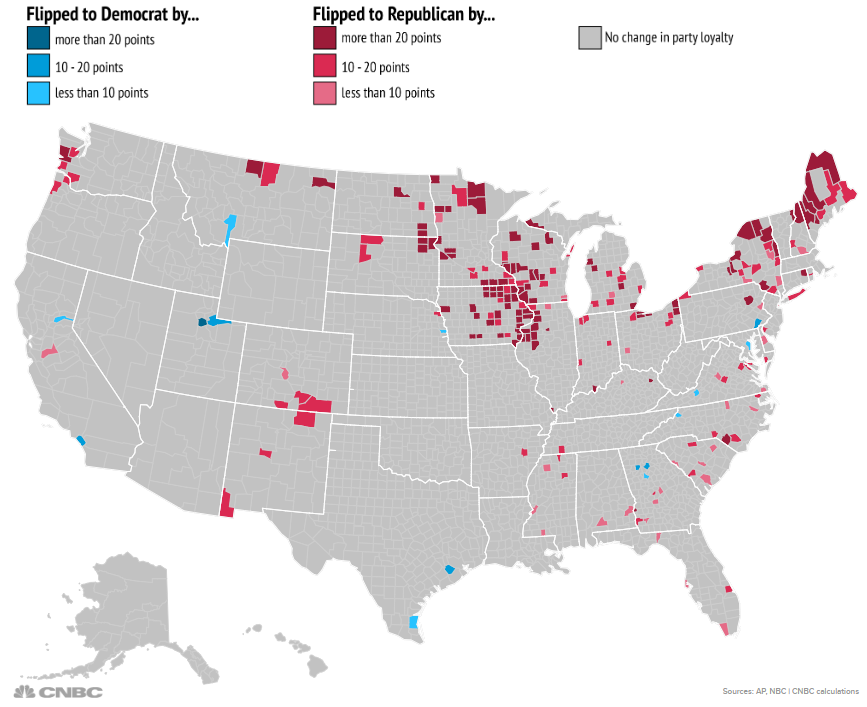
Bring Back the Obama Coalition. A third argument for electability is to look for someone who can increase African-American turnout to 2012 levels. As political scientists John Sides, Michael Tesler, and Lynn Vavreck point out in their book on the 2016 election, African-American turnout dropped five percent nationally and even more in swing states. Decreases of over 12 percent in Michigan and Wisconsin were especially devastating to Hillary Clinton.[1]
No one can quite put their finger on the reasons for this drop. Clinton herself blames stricter voting laws. I have argued, along with others, that digital voter suppression techniques aimed at African American voters and pushed by the Russian Internet Research Agency may have contributed to critical drops in the black vote. Others counter that it was unrealistic to expect high black turnout for a white candidate regardless of how sympathetic he or she might be to the black community. This argument leads one towards the candidates of color in the race—Senators Cory Booker and Kamala Harris.
Win some more white men. To the surprise of many, the fact that Hillary Clinton was the first woman to run for president as the nominee of a major political party did not result in an advantage sufficient to win. In the exit polls in 2012, Obama also did better among women by 11 points, and Romney did better among men—but by only 7 points. In 2016 Hillary did better among women by 13 points, but Trump did better among men by 11 points and among white men Trump’s advantage was even bigger. This is a tough one to explain but Sides et. al. use a composite measure that they call “Modern sexism” to characterize the voters in 2012 and 2016. They conclude: “Although Clinton appeared to do somewhat better than Obama among white men who scored low in modern sexism, white men with higher scores were more likely to vote for Trump than they had been to vote for Romney… In the exit poll Clinton lost white men by a whopping 31 points—a wider margin than any candidate since Walter Mondale lost forty-nine states to Ronald Reagan in 1984.”[2]
Thus, for the many well-qualified women running in the 2020 Democratic primaries, the electability question boils down to a straightforward challenge: can you hold onto (or increase) the women’s vote without creating a nearly equal or greater backlash among men? So far in Trump’s presidency, women remain far more critical of his performance in office than men. In fact, Pew Research finds that the gender gap in presidential approval ratings under Trump is larger than for any recent president. While men are evenly split (47 percent approving and 47 percent disapproving) on how Trump is handling his job, among women 32 percent approve while 63 percent disapprove. If these numbers were to translate into votes it could provide a significant advantage to the democratic nominee.
All of this is a tall order but not an impossible one. Any nominee will need to hold onto what Hillary won. In addition they will need to do one or two of the following: add a few key states, woo back some Trump voters in key places, increase African-American turnout and attract enough white men to narrow the Democrats’ gender gap. Ready, set, go!
[1] Identity Crisis: The Presidential Campaign and the Battle for the Meaning of America, (Princeton University Press, 2018)
[2] Ibid, page 188.
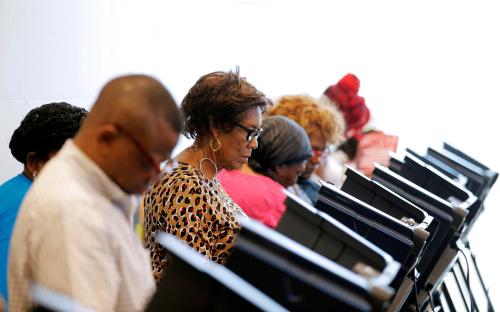
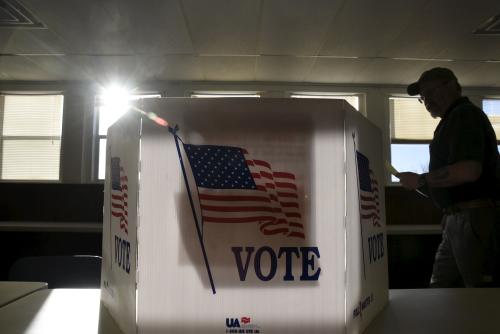
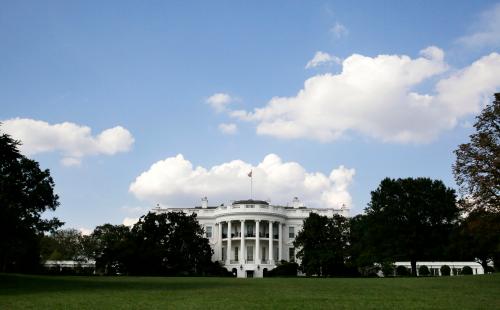
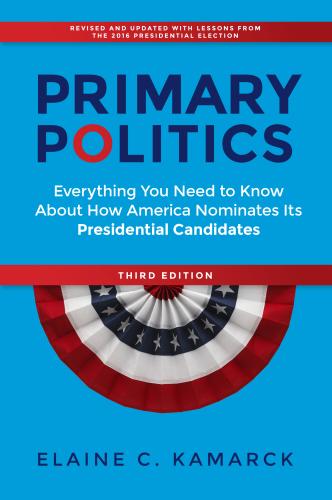




Commentary
The Democratic Race: Taking a hard look at electability
May 3, 2019